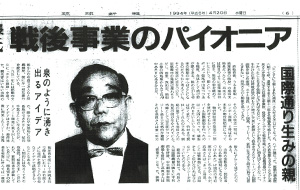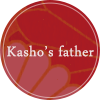


 Kasho's father, Hajime Takara, was a member of the Naha City Municipal AssemblyCouncil for 6 terms (17 years). He was a pioneer of post-war rebuilding recovery in Okinawa and is known as the founder of "Kokusai Dori" (International Street).
Kasho's father, Hajime Takara, was a member of the Naha City Municipal AssemblyCouncil for 6 terms (17 years). He was a pioneer of post-war rebuilding recovery in Okinawa and is known as the founder of "Kokusai Dori" (International Street).
My father,father was loved by many people in Okinawa and his lifeworks was were featured in an article in the Ryukyu Newspaper upon his passing. I have selected some excerpts as set out below.
"A fFormer chairmanpresident of the Naha City Municipal AssemblyCouncil, Hajime Takara, a post-war business pioneer"
The founder of the Kokusai Dori
Hajime Takara, whom we adoringly affectionally called "Bin-san", has passed away on the 6th. He was 86 years old. [A six term (17 years) Naha City Council member and a three term (12 year) well-known chairman career.More than his political career, to talk about Takara shall be means revealed highlighting in his appetitepassion toward business, his wide variety of ideas, and his status as Okinawa's post-war pioneer in every various businesses. The wealth ofHis ideas he had flowed freelycontinuously like a springfountain. Takara was involved in creating the Ernie Pyle International Theatre so that people could enjoy some motion picture entertainment during a time when most people had nothing. He was thealson involved in finance, hotel construction, resort development, monorails, newspapersand newspapers etc – so many businesses that one cannot count on their fingers even when using both hands. We have investigated to find outsearched more of Takara'shis character.
Back when after the war, Takara was the bureau chief for the URUMA SHINPO newspaper (the previous incarnation of the Ryukyu ShimpoRYUKYU SHINPO), he would climb to the top of SHURI Castle almost every day and look out at the city of Naha. The city back then had a handful of small villages here and there, but it was burned and barren for the most part. He would look out at the view and imagine where the centre of Naha's future would lie, and that is when he caught his eyes on MAKISHI. The Naha City's recovering seemed slow, and MAKISHI was located in the center ofbetween Shuri, Mawashi, Naha and Oroku area.. Back then, the entire area of Makishi was being used by the KURONBO Unit of the U.S. Army as a base. Takara received approval to use a part of the supplies collection area base build the Ernie Pyle International Theatre in 1948. When he requested the U.S. Army for an approval of the theatre construction, they graciously granted him permission and even provided some construction materials.
Takara's foresight was able to be seen in the building itself. The theatre was built very sturdily for a building of that time, complete with a concrete entrance. Takara chose to set it back by one house's space away from the road as he believed that Kokusai Dori (named after the theatre), which at the time was only as wide as a normal road, would eventually become a busy shopping street and he felt that he needed to widen the road.
The theatre was a success, and Takara then created the Heiwa-kan adjacent to the theatre. He then bought out the Chuo Theatre and the Naha Theatre to and soon becaome the "King of Entertainment". With the profit from the various theatres, Takara created Okinawa Mutual Loan Company with his friends, and eventually founded Dai-ichi Sogo Bank.
In 1951, Takara built Hotel Ryukyu in the Ameku district of Naha City. As there weren't any tourists at the time, the hotel targeted and catered to U.S. Military Officers who needed a temporary place to stay before finding a more permanent residence in Okinawa. The hotel was built on grounds less than 10,000 square metes and was a two story Western style building with abeautiful red tile roof. It was subsequently sold to Tokyu, which renovated into "Naha Tokyu Hotel", which still stands tillo this day.
Takara's passion fortoward business did not subside and in 1955, he took the role of the development of Nakagusuku Park. At the same time, he founded Ikeijima Health Centre, a former facility of the U.S. Army Communications Squadron which was left behind to the local people when they army abandoned Ikeijima. He also had impressive resort development ideas on the [neighbouring island, Henzajima, which he had to cancel the idea because of a petroleum station development. One can see a part of Takara's sympathy when the resort development boom occurred after the Ocean Expo.
As the chairman of the Naha City Council, Takara's foresight visions and abilities were full filling. He founded a Planning of Establishment Group for the City Monorail Development Promotion Council, and appealed to the prefecture around 20 years ago in 1977. His plans were at a grand scale level. The first phase would bring the monorail to Naha City, the second phase would stretch it all the way to Okinawa City, and the third phase planned to then extend the line all the way to the Ocean Expo Venue. The monorail's development that got off grounds was an offering to the late Takara.
Just before the Ocean Expo, Takara once again became the centre of attention. He proposed a canal development between Ishikawa and Nakadomari, the narrowest part of Okinawa measuring just 3 kilometres.
On a personal level, Takara was a very companionable man and had his love on awamori (local liquor made from rice). He was also dubbed the "owner of Sakurazaka" and due to his past in as a journalist, enjoyed inviting acquainted journalists to Sakurazaka for a lively drink. He was also a very skilled story teller I am sure that even in the after world, he is still coming up with a large amount of abundant ideas.
(Ryukyu Newspaper, April 20, 1994 – excerpts taken from article)
My father passed away after battling his disease for 3 years, in 1994.







